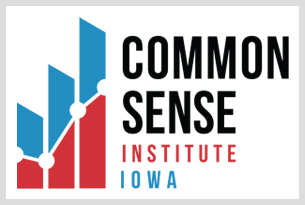Author: Ben Murrey
All the data referenced in this report come from the U.S. Bureau of Labor Statistics’ Consumer Price Index (CPI) database. This source produces estimates of price levels neither for Iowa exclusively nor for any metropolitan area within Iowa; therefore, this report references data from the Midwest region (Illinois, Indiana, Iowa, Kansas, Michigan, Minnesota, Missouri, Nebraska, North Dakota, Ohio, South Dakota, and Wisconsin) to represent changes in consumer prices in Iowa.
Key Findings
- In March, the average midwestern household spent over $1,000 more due to inflation relative to 2020. The average household has spent $24,750 more since 2020 because of higher inflation.[i]
- From February to March, prices across all consumer goods rose by 0.7% in the Midwest. This was the highest rate of inflation since January 2023.
- While month-over-month Midwest region inflation eclipsed the national increase of 0.4%, overall inflation has stayed lower in the Midwest since the pandemic. Inflation over the last year came in at 2.8% for the Midwest, showing no increase over February, versus 3.5% for the U.S., up from 3.2% in February.
- In the Midwest, annual inflation bottomed at 2.4% last June and monthly inflation bottomed at -0.2% in November and December. This month’s inflation numbers confirm a new upward trend in monthly inflation.
- In the Midwest region from March 2023 to March 2024, the price of services grew by 4.45% and the price of housing grew by 4.06% while the price of durables fell by 3%.
- In the recent winter month, energy price deflation brought down headline CPI with a fall of 7.8% in energy prices from January 2023 to January 2024. From March 2023 to March 2024, energy inflation came in at 0.61%, ending the downward pressure on overall inflation from energy.
Iowans need $1,000 more per month just to keep up
In early 2021, inflation across the United States began to rise at rates far above the historic norm. In the Midwest, consumer prices have risen by over 20% since March of 2020 when emergency fiscal and monetary measures went into effect to blunt the impact of economic shutdowns. As a result, the typical Iowa household must now spend $1,006 per month more than it did in 2020 to maintain the same standard of living. That same household has spent an additional $24,748 since 2020 to maintain the same standard of living. The cost increases have been led by a surge in housing, transportation, and food prices, which have risen by $328, $302, and $150 per month, respectively. Figure 1 shows the cumulative increases in costs since 2020.
Inflation in the Midwest is trending back up in 2024
Looking at the downtrend in inflation in 2023, Common Sense Institute’s January inflation report suggested the trend of surging prices since the start of the pandemic may be reversing. It noted, however, that the January month-over-month number put a trend reversal into question, concluding, “The next few months’ data will help to clarify whether inflation will remain sticky, or the disinflation trend of 2023 will hold.” That data indeed puts the trend reversal into question and points to stickier inflation ahead.
While the cost of living will likely never return to 2020 levels, consumer prices fell for Midwesterners in the last three months of 2023. Unfortunately, inflation returned in the new year. Year-over-year inflation has remained relatively steady since the start of the year, but the monthly rate of inflation in the Midwest has risen every month in 2023. The month-over-month deflation Midwesterners enjoyed in the last quarter of 2023 still factors into annual inflation numbers, keeping the annual number steady—for now.
If month-over-month inflation continues to trend higher or even stay at the elevated levels seen since the start of 2024, inflation in the Midwest. At 2.8%, inflation in the Midwest currently trails United States inflation of 3.5%. The current monthly rate of inflation annualized, however, would bring inflation to 8.4% for the Midwest and just 7.2% for the United States. Over the coming months, month-over-month inflation will need to cool significantly to prevent a return to the elevated inflation figures seen from the spring of 2021 through the spring of 2023. Figure 2 and Figure 3 shows the trends in month-over-month and annual inflation.
Annual Inflation Stays Low Across Consumer Categories
While month-over-month inflation surged in March, annual inflation in the Midwest remained low relative to 2022 and 2021 across most consumer spending categories. From March 2023 to March 2024, the price of services grew by 4.5% and the price of housing grew by 4.1% while the price of durables fell by 3% and education fell by 0.4%. On a month-over-month basis, however, energy rose by the greatest amount at 3.6% followed by transportation at 2.8%. At a 1.1% decrease, fuels and utilities fell the most of any category.
[i] Impacts on household spending are generated by distributing the consumer expenditure estimates from https://web.archive.org/web/20220121095708/https://www.bls.gov/regions/midwest/data/consumerexpenditures_selectedareas_table.htm across individual months, weighting them according to their corresponding CPI levels, and adjusting them according to the latter’s growth history.

